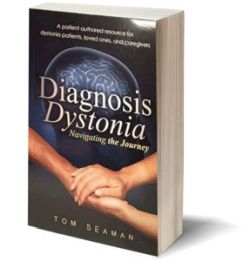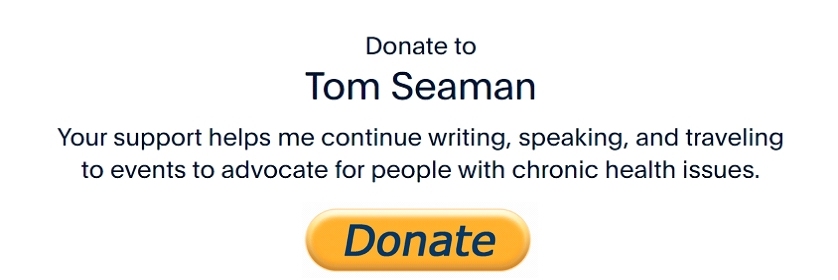Tips to save your neck and back working on the computer
The way we perform activities throughout the day can greatly impact how we feel. Our body learns by repetition, so our daily habits are critical. I find them so important that I devoted an entire chapter to them in my dystonia book, sharing different ideas, tips, and tricks for doing different everyday activities with greater ease. Recently, I have been hearing from lots of people who are having difficulty working at their computer, so I want to focus on this particular topic. What I have to share is my opinion and not universal, but hopefully you find these ideas helpful. Many of these things also apply to the use of the phone.

For a bit of history, when my dystonia and chronic pain symptoms were more severe, I had to push my head straight to see the computer screen and was only able to type with one hand, like many of you. I pushed so hard, I had a red welt on the side of my chin. For those of you that need to hold your head for support, by all means do so. Putting a pillow or a book under the arm you use to hold your head might make it easier so you don’t slouch or lean to one side. This is how I started. Over time, I only had to lightly touch my chin using an antagonistic gesture (sensory trick) to keep my neck muscles from pulling. I then got to where I didn’t need to hold my head or cup my chin in my hand.
Aside from the obvious pain and fatigue that comes with dystonia, one of the main culprits of neck and back pain when we work on the computer is poor posture and improper use of armrests, or not using them at all. Resting our arms at certain angles or holding them up to type puts stress on the neck, shoulders, and back. Even people without dystonia develop problems in these areas when they don’t use armrests or when they use them improperly, but it is especially important for us.
Many of us have laptops, smart phones, tablets, iPads, etc., making it so we can sit, stand, or lay down wherever we want to do our work. However, we tend to get lazy and find the most comfortable position, which is usually one that promotes poor posture. Some people will put their gadget on a desk or table where they have to lift their arms up and/or out to reach the keys to type. Some put them on a coffee table or bed and then lean forward to type. You can see below how much potential harm different postures cause using the phone. This goes for all other devices.

All of this puts WAY too much strain on the body if the arms, shoulders, and neck are not evenly supported. Even sitting with computers on our laps can promote poor posture, typically one that is slumped or rounded. It also happens when we type on our phones. This posture shortens/tightens our muscles, potentially increasing symptoms.
Below is an image showing one of the ways to not sit at the computer. At first glance it looks like he is in a good position, and for the most part he is, but notice the amount of space between his arm and armrest, forcing him to engage much more of his upper body than necessary.

Although he is sitting in good posture and not reaching for the keyboard, holding his arms in the air to type strains his neck, shoulders, and back. Also notice the upward angle of his arms to the keyboard, the opposite they should be for a relaxed working position.
This man has dystonia and his primary area of pain, muscle spasms, and tightness is his neck, shoulders, and base of the skull, and it is at its worst when he works. When he modified his work station that allowed him to rest his arms at a stress free angle, it massively reduced his symptoms.
I use a laptop and because I can’t find a comfortable position to sit and work without reaching for the keys and straining my neck and shoulders, I bought a wireless keyboard and mouse. I also bought a desk that has a slide out keyboard tray. I put the wireless keyboard and mouse on the slide out tray and the laptop on the desk. I have a desk chair where the armrests slide right up to the keyboard tray (see below).
My arms are at a level that when I am typing my hands sit comfortably on the keys. There is a slight downward angle from my elbows to my hands to the keyboard, which keeps my shoulders relaxed. My screen is a little below eye level so I don’t have to strain to hold up my head or lean it forward or back. My chin is slightly pulled back and tucked, keeping my head and neck in a neutral position. I also use an Obusforme back support to help with posture.
Below is a picture of my work station. I certainly don’t have the best posture in the world and my core is not as engaged as well as it could be, but notice how my elbows sit comfortably on the armrests and my arms angle downward toward the keyboard, taking stress off my neck and shoulders. This position allows me to work longer hours.

 __________________________________
__________________________________ Tom Seaman is a Certified Professional Life Coach in the area of health and wellness, and the author of 2 books: Diagnosis Dystonia: Navigating the Journey and Beyond Pain and Suffering: Adapting to Adversity and Life Challenges. He is also a motivational speaker, chronic pain and dystonia awareness advocate, health blogger, volunteer for the Dystonia Medical Research Foundation (DMRF) as a support group leader, and is a member and writer for Chronic Illness Bloggers Network, The Mighty, and Patient Worthy. To learn more about Tom, get a copy of his books (also on Amazon), or schedule a free life coaching consult, visit www.tomseamancoaching.com. Follow him on Twitter @Dystoniabook1 and Instagram.
Tom Seaman is a Certified Professional Life Coach in the area of health and wellness, and the author of 2 books: Diagnosis Dystonia: Navigating the Journey and Beyond Pain and Suffering: Adapting to Adversity and Life Challenges. He is also a motivational speaker, chronic pain and dystonia awareness advocate, health blogger, volunteer for the Dystonia Medical Research Foundation (DMRF) as a support group leader, and is a member and writer for Chronic Illness Bloggers Network, The Mighty, and Patient Worthy. To learn more about Tom, get a copy of his books (also on Amazon), or schedule a free life coaching consult, visit www.tomseamancoaching.com. Follow him on Twitter @Dystoniabook1 and Instagram. 




























Hi Tom, These are all great tips. I wanted to make you aware of a new device called Upright Go that is a biofeedback device that sticks to your skin between your shoulder blades and vibrates whenever you slouch. This helps you to retrain your muscle memory and leads to more awareness of your body’s position. I’ve had DBS and have a Medtronic Neurostimulator and I have not had any compatibility issues using the Upright Go. It’s available on Amazon for about $100.
Thanks Jeff. I have seen that before but never tried it. So simple, yet looks so effective. What is even better to hear is that there are no contraindications with the DBS system. I really appreciate you mentioning it. Here is a link for anyone interested in the Upright Go: http://uprightgo.com/ IF you have ever tried it, or if you do, please let us know what you think of it. Thanks again Jeff!